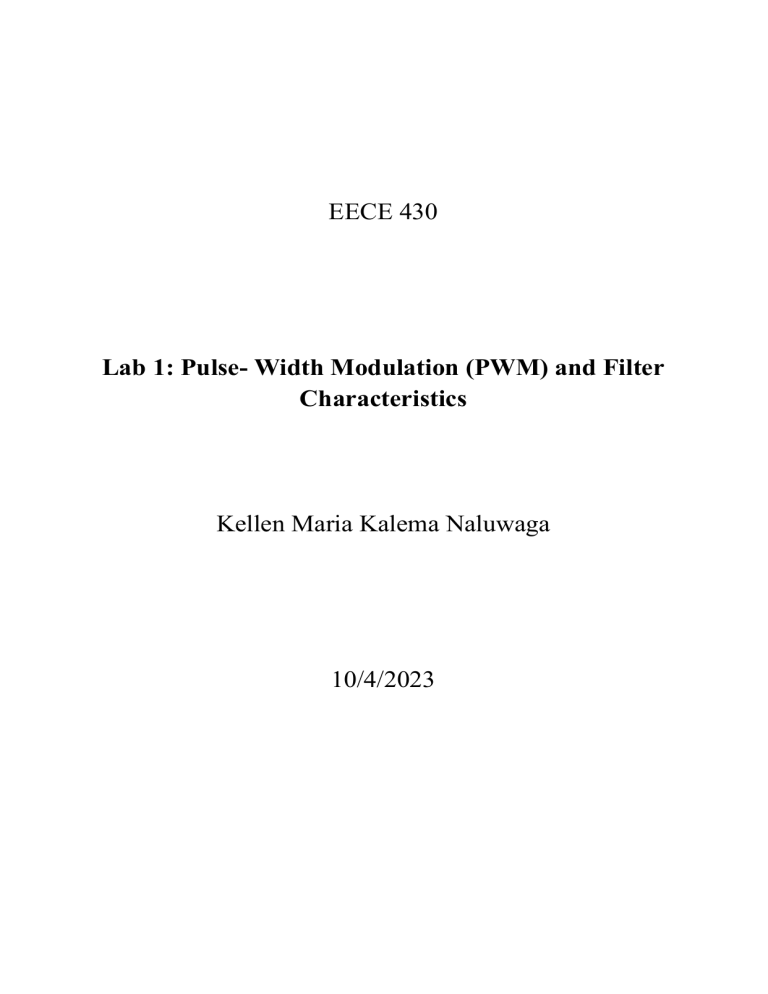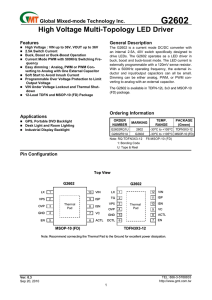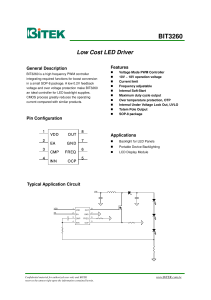
EECE 430 Lab 1: Pulse- Width Modulation (PWM) and Filter Characteristics Kellen Maria Kalema Naluwaga 10/4/2023 Objectives Component and Equipment List Analysis of Input voltage VA and the Output Voltage Vo Analysis of Input Source Characteristics a. Pulse Width Change Analysis to 6us b. Switching Frequency Change Analysis to 20kHz c. Pulse width Change Analysis to 5us Transfer function Analysis of Vo(s)/VA(s) 1 Objectives The main objective of the lab is centred around exploring and understanding the relationship and behaviour of electrical circuits in response to pulse width modulation (PWM) and varying input conditions. Through experiments with different PWM settings, AC input, and analyses like Fourier and transfer functions, the lab delves into practical aspects of how circuit elements (L, C, and R) respond to different frequencies and harmonic components, specifically focusing on transient responses, resonance, and filtering characteristics. By simulating and/or physically measuring parameters like voltage, current, and frequency under varying scenarios, the lab aims to deepen understanding of circuit theory, electrical resonance, and filtering in practical, real-world applications. Component and Equipment List PSpice Analysis of Input voltage VA and the Output Voltage Vo Image showing built Buck Converter Circuit/LC low-pass filter In the circuit configuration, where VA is the voltage across an inductor in series with a PWM voltage source, and V0is the voltage across a resistor and capacitor in parallel (placed in parallel to the PWM voltage source), determining the exact moment when V0 reaches steady state will depend on Duty Cycle. The average value of the PWM waveform, which influences the final steady-state value of V0 is determined by its duty cycle. A higher duty cycle would raise the average voltage and therefore the steady-state value of V0. 2 Image showing plot of the input voltage VA and the output voltage VO Relation between VO and VA Given VAis the voltage applied across an inductor (L) in series with a PWM source, and V0 is the voltage across a resistor (R) and capacitor (C) in parallel, which are in parallel with the PWM source, VA is a Pulse Width Modulated (PWM) signal. The average voltage (Vaverage) across the inductor due to the PWM can be calculated using the duty cycle (D) and high/low voltage levels (VH and VL) of the PWM: VAavg =VL +D×(VH−VL). When the PWM signal is applied across the inductor, due to its property to resist changes in current, the inductor will smooth out the variations in VA, creating a more DC-like voltage (with some ripple) across it. The resistor (R) and capacitor (C) parallel combination forms a low-pass filter. If the PWM frequency is sufficiently high, V0 will approximate the average DC value of VA (VAavg), though with some ripple. The exact ripple and transient response characteristics depend on the L and RC values, as well as the PWM frequency and duty cycle. In summary, under steady-state conditions: V0 ≈VAavg 3 No.3 VA Component 4 V0 Component In a buck converter, the average of V0 (output voltage) should be approximately equal to the average of VA (input PWM voltage) under steady-state conditions. The fundamental frequency of a PWM signal is equal to its switching frequency. If you generate a PWM signal with a period T, the fundamental frequency f1 is the inverse of this period: f1 = 1/T The resonance frequency ( fres) of an LC circuit is given by: Fres = 1/ (2π sqrt(LC)) Where L is the inductance and C is the capacitance in the filter. The ratio of the switching frequency fs to the LC resonance frequency can be expressed as: Ration= fs / fres The attenuation of the fundamental frequency by the LC filter depends on the filter design and the ratio of the switching frequency to the LC resonance frequency. The LC filter provides a low-pass filtering effect, ideally allowing DC and low-frequency signals to pass while attenuating high-frequency signals. 6 us Pulse width The duty cycle (D) of the PWM signal is defined as the ratio of the pulse width (PW) to the period (T) of the waveform. D = PW/ T . Changing PW from 6µs to 7.5µs, while keeping the period (T) constant, will increase D, altering the average value of the PWM signal and hence the DC component delivered to the load. 5 Image showing plot of the input voltage 6us VA and the output voltage VO Relation between VO and VA Given VAis the voltage applied across an inductor (L) in series with a PWM source, and V0 is the voltage across a resistor (R) and capacitor (C) in parallel, which are in parallel with the PWM source, VA is a Pulse Width Modulated (PWM) signal. The average voltage (Vaverage) across the inductor due to the PWM can be calculated using the duty cycle (D) and high/low voltage levels (VH and VL) of the PWM: VAavg =VL +D×(VH−VL). When the PWM signal is applied across the inductor, due to its property to resist changes in current, the inductor will smooth out the variations in VA, creating a more DC-like voltage (with some ripple) across it. The resistor (R) and capacitor (C) parallel combination forms a low-pass filter. If the PWM frequency is sufficiently high, V0 will approximate the average DC value of VA (VAavg), though with some ripple. The exact ripple and transient response characteristics depend on the L and RC values, as well as the PWM frequency and duty cycle. In summary, under steady-state conditions: V0 ≈VAavg 6 6us VA Component In a buck converter, the average of V0 (output voltage) should be approximately equal to the average of VA (input PWM voltage) under steady-state conditions. The fundamental frequency of a PWM signal is equal to its switching frequency. If you generate a PWM signal with a period T, the fundamental frequency f1 is the inverse of this period: f1 = 1/T The resonance frequency ( fres) of an LC circuit is given by: Fres = 1/ (2π sqrt(LC)) Where L is the inductance and C is the capacitance in the filter. The ratio of the switching frequency fs to the LC resonance frequency can be expressed as: Ration= fs / fres The attenuation of the fundamental frequency by the LC filter depends on the filter design and the ratio of the switching frequency to the LC resonance frequency. The LC filter provides a low-pass filtering effect, ideally allowing DC and low-frequency signals to pass while attenuating high-frequency signals. 7 6us VO Component N0. 5 (Switching Frequency) The fundamental frequency of the PWM signal now becomes 20kHz ensuring that the pulse width is appropriate to maintain desired duty cycle values at the new frequency. The relationship between the switching frequency and the LC filter (or other present filters') resonant frequency affects the output voltage, ripple, and transient response. The increased simulation time allows the circuit to reach a steady state, especially if the frequency changes have affected the transient response time. The Longer simulations provide a more detailed look into slow-changing variables and low-frequency behaviours. 8 Image showing plot of the input voltage 20kHz VA and the output voltage VO Relation between VO and VA Given VAis the voltage applied across an inductor (L) in series with a PWM source, and V0 is the voltage across a resistor (R) and capacitor (C) in parallel, which are in parallel with the PWM source, VA is a Pulse Width Modulated (PWM) signal. The average voltage (Vaverage) across the inductor due to the PWM can be calculated using the duty cycle (D) and high/low voltage levels (VH and VL) of the PWM: VAavg =VL +D×(VH−VL). When the PWM signal is applied across the inductor, due to its property to resist changes in current, the inductor will smooth out the variations in VA, creating a more DC-like voltage (with some ripple) across it. The resistor (R) and capacitor (C) parallel combination forms a low-pass filter. If the PWM frequency is sufficiently high, V0 will approximate the average DC value of VA (VAavg), though with some ripple. The exact ripple and transient response characteristics depend on the L and RC values, as well as the PWM frequency and duty cycle. In summary, under steady-state conditions: V0 ≈VAavg 9 20kHz VA Component In a buck converter, the average of V0 (output voltage) should be approximately equal to the average of VA (input PWM voltage) under steady-state conditions. The fundamental frequency of a PWM signal is equal to its switching frequency. If you generate a PWM signal with a period T, the fundamental frequency f1 is the inverse of this period: f1 = 1/T The resonance frequency ( fres) of an LC circuit is given by: Fres = 1/ (2π sqrt(LC)) Where L is the inductance and C is the capacitance in the filter. The ratio of the switching frequency fs to the LC resonance frequency can be expressed as: Ration= fs / fres The attenuation of the fundamental frequency by the LC filter depends on the filter design and the ratio of the switching frequency to the LC resonance frequency. The LC filter provides a low-pass filtering effect, ideally allowing DC and low-frequency signals to pass while attenuating high-frequency signals. 10 20kHz V0 Component NO. 6 (50% Duty Ratio) A 50% duty cycle implies that the average voltage (Vavg) of the PWM signal will be half of the peak voltage (assuming a symmetric waveform starting from zero). This could alter the DC level to which capacitive and inductive elements charge. The transient response of LC and RC elements to the change in PWM pulse width can result in over/undershoots, longer settling times, and altered peak responses. The time constants associated with L, R, and C will determine how quickly the circuit responds to changes, and this may be reflected in different inrush currents, dV/dt, and dI/dt during transitions. the amplitude of the fundamental frequency in the frequency domain (Fourier series) is calculated as follows: A1 = 4⋅Vpeak / π . Here: A1 is the amplitude of the fundamental frequency component. 11 Vpeak is the peak voltage of the square wave. If, for instance, you are switching between V1 =0V and V2 =10V, then Vpeak will be 10V. Amplitude = (4*10)/pi = 12.73V So, the amplitude of the fundamental frequency component of a 10V, 50% duty cycle wave is approximately 12.73V. This is larger than the peak value of the time-domain signal due to the nature of Fourier decomposition, where the square wave is represented as a sum of sine waves. N0. 7 (Transfer Function Analysis) Image showing plot of the input voltage VA and the output voltage VO from an AC Voltage Component When the pulse voltage input is replaced with an AC voltage input, the relationship between the frequency at which the transfer function gain peaks and the LC resonance frequency can be analysed. In a simple series LC circuit, resonance occurs when the inductive and capacitive reactances cancel each other out. The transfer function describes the relationship between the input and output of a linear time-invariant system in the frequency domain. The frequency at which the transfer function gain peaks coincides with the LC resonance frequency because at this frequency, the impedance is minimised (or maximised in a parallel LC circuit), allowing maximum current (or voltage in parallel LC) to flow through the circuit. NO. 8 The attenuation of the fundamental frequency depends on the specific circuit configuration and components involved. Attenuation, A in dB, is given A=20log10(∣H(jω1)∣). Note that a gain of less than 1 (or -dB) means the signal is attenuated at this frequency. 12








